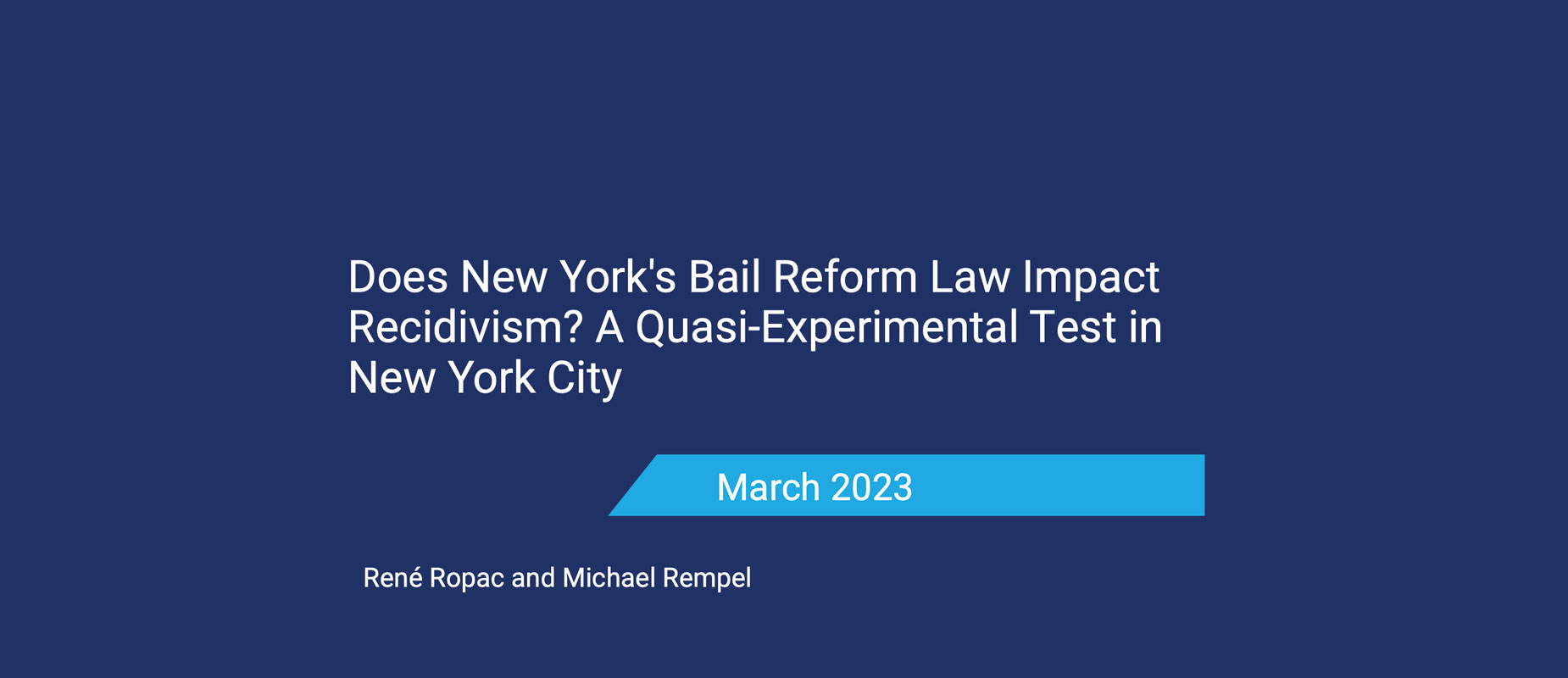
John Jay College’s Data Collaborative for Justice Finds Significant Reductions for Any Re-Arrest Over Past Two Years
In a first of its kind “apples to apples” test of bail reform and re-arrest, a new study by the Data Collaborative for Justice at John Jay College (DCJ) reveals that, overall, a failure to pass the original bail reforms would have resulted in a higher re-arrest rate in New York City. In short, it achieved legislators desired impact of advancing justice without harming public safety.
This report, Does New York’s Bail Reform Law Impact Recidivism? A Quasi-Experimental Test in New York City, offers a unique look at bail reform and recidivism in New York City. The analyses compared re-arrest on any charge, a felony, a violent felony, and a firearm charge between people released under the reforms and statistically similar people (based on charges, criminal history, and demographic background) who faced bail or a remand order. DCJ tracked recidivism over a minimum of two years for everyone studied.
No previously reported bail data tracked recidivism beyond the pretrial period or compared statistically similar people released versus those facing bail or remand.
“Our goal with this study was to substantially upgrade the credibility of information known to New Yorkers about bail reform and recidivism,” said Michael Rempel, Director, Data Collaborative for Justice. “Fundamentally, we found that eliminating bail for most misdemeanors and nonviolent felonies reduced recidivism in New York City, while there was no clear effect in either direction for cases remaining bail eligible. We also dug deeper into results for different subgroups, such as those with and without a prior criminal history.”
DCJ also distinguished cases by whether the reforms made them ineligible for bail and separately estimated the recidivism impact of: (1) eliminating bail for select cases; and (2) reducing the use of bail for people remaining legally eligible for it through measures such as supervised release expansion.
“The main takeaway from this study is that the expanded use of alternatives to bail and pretrial detention led to a net reduction in recidivism in New York City,” said René Ropac, Senior Research Associate, Data Collaborative for Justice. “The findings also underscore the need for a more nuanced debate. Original bail reform had an overall beneficial impact on recidivism, but we also found clear evidence that the 2020 amendments that made certain cases bail eligible again further enhanced public safety. The results suggest that additional careful improvements to New York’s bail law are possible.”
Beyond addressing urgent “bottom-line” questions such as whether bail reform affected recidivism overall, DCJ also examined for whom bail reform had more or less beneficial effects (based on people’s charge severity or criminal history). Finally, the report examined whether and how the mid-2020 amendments that expanded legal eligibility for bail impacted recidivism.
What’s the upshot?
The study yielded four umbrella themes based primarily on comparing statistically similar people released in 2020 versus facing bail or remand in 2019.
- Eliminating bail for most misdemeanor and nonviolent felony charges reduced recidivism. Hi
- Across all cases seeing the elimination of bail, there were reductions for any re-arrest (44% vs. 50%) and felony re-arrest (24% vs. 27%) over two years.
- Additionally, over a longer 30-month follow-up period, people released post-reform were less quickly re-arrested for any offense, a felony offense, or a violent felony offense than people who had bail set or were remanded pre-reform.
- Releasing more bail eligible people (due to measures such as supervised release expansion or the “least restrictive condition” provision) did not affect recidivism in any direction.
- The 2020 amendments targeted a specific subgroup (about 6% of total cases for which bail was originally eliminated) in a way that enhanced safety. In practice, almost all cases affected by the amendments fall into three categories: “harm-harm” cases (53%); domestic violence cases involving the obstruction of breathing (30%); and a subset of second-degree burglary cases (12%).
- For cases impacted by the mid-2020 amendments, the original bail reforms led to an increase in any re-arrest (58% vs. 53%), felony re-arrest (37% vs. 30%), and violent felony re-arrest (24% vs. 16%).
- Re-arrest rates increased among “harm-harm” cases (81% vs. 52% among harm-harm cases with a current felony charge) and affected second-degree burglary cases (53% vs. 34%).
- However, re-arrest rates decreased among affected domestic violence cases involving obstruction of breathing under the original reforms (37% vs. 45%)
- Hence, overall the mid-2020 amendments targeted a specific subgroup of people in a way that likely reduced recidivism, landing the State’s reforms in a place producing greater net public safety benefits than those already achieved under the original law.
- In general, bail reform tended to reduce recidivism for those facing less serious charges and with limited or no recent criminal history over the prior 2 years, and tended to increase recidivism for those with substantial recent criminal histories. The clearest findings across all analyses were that release under bail reform reduced recidivism especially for people with no recent prior arrest (in the preceding two years), while increasing recidivism for people with a recent prior violent felony arrest. Please see our report for exactly when these patterns did and did not apply.
This is the first in the Data Collaborative for Justice’s Bail Reform and Recidivism Series. Additional studies forthcoming in 2023 will examine recidivism impacts in regions outside New York City and will test for system-wide shifts in re-arrest rates across all cases subject to mandatory release from pre-reform (2017-2019) to post-reform (2020) legal contexts all across the state. Additionally, in 2024, the present study will be updated over a longer tracking period.
The full report is available on the Data Collaborative for Justice’s website.
The Data Collaborative for Justice (DCJ) leads critical research about frequent interactions between community members and the criminal legal system and aims to ensure that communities, and the governments that serve them, have the necessary information to develop and implement evidence-based policies, practices, and programs. DCJ’s work has informed policy reforms, facilitated partnerships between researchers and government agencies across the country, spurred new scholarly research on lower-level enforcement, and been cited extensively in the press. More information about the Data Collaborative for Justice’s work is available at their website.
This analysis and report was generously supported by funding from Arnold Ventures.



